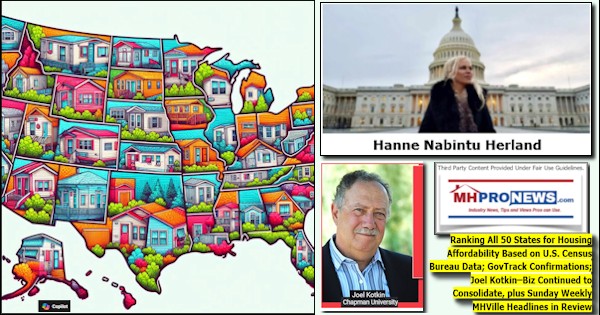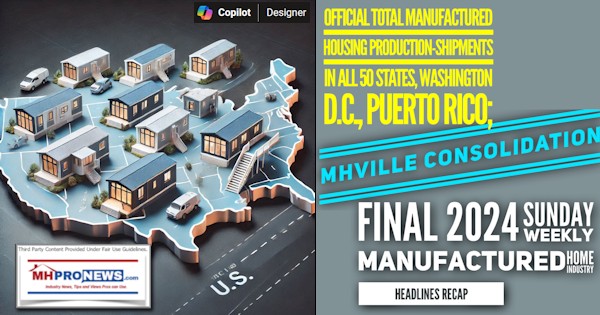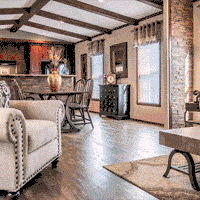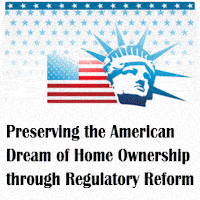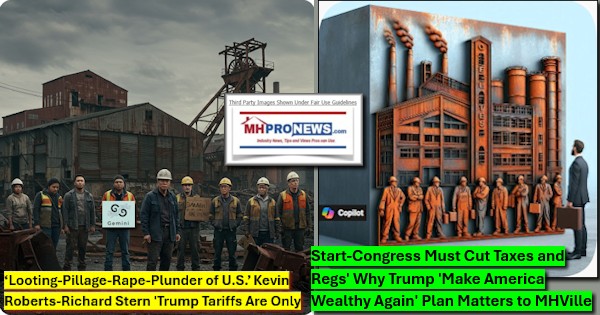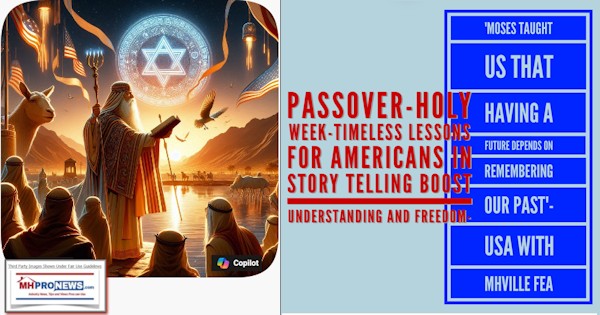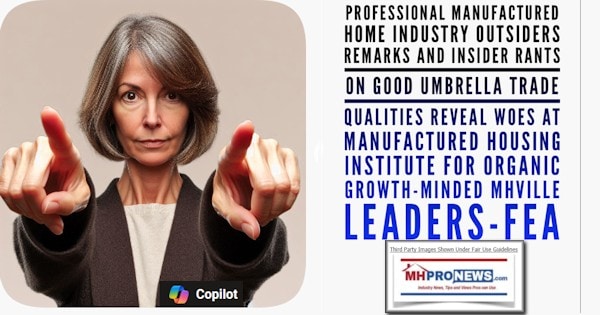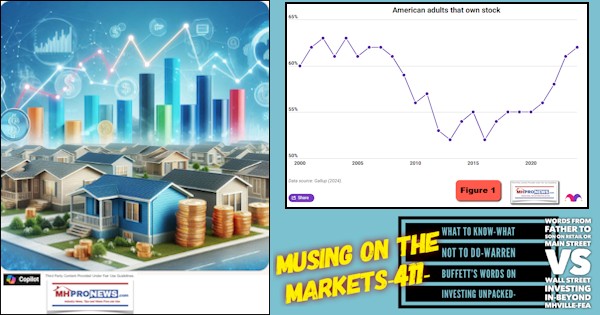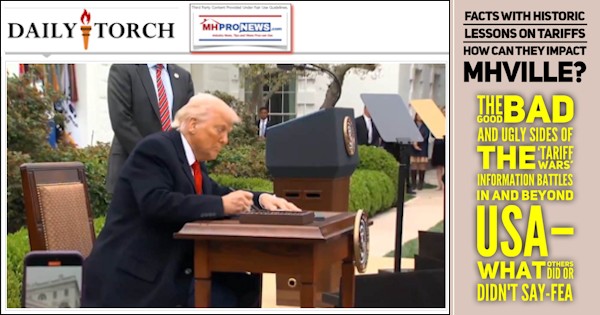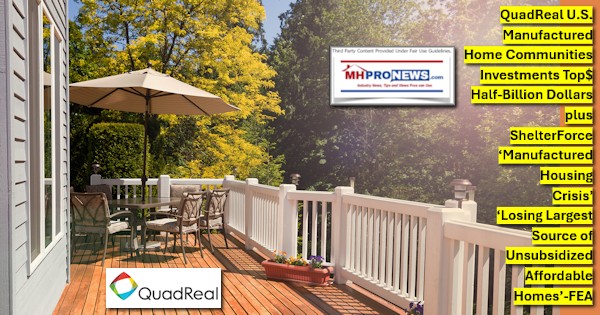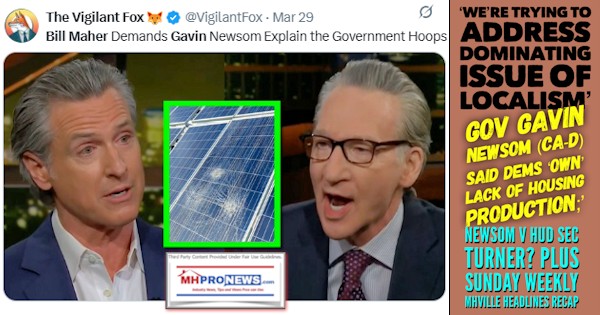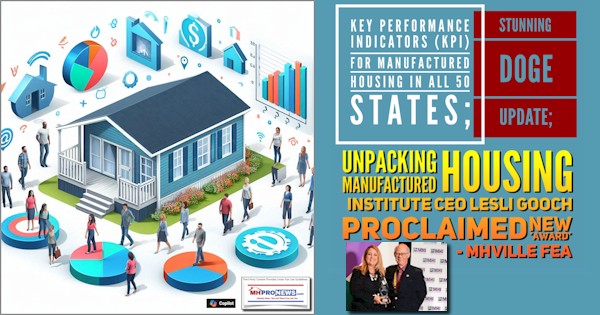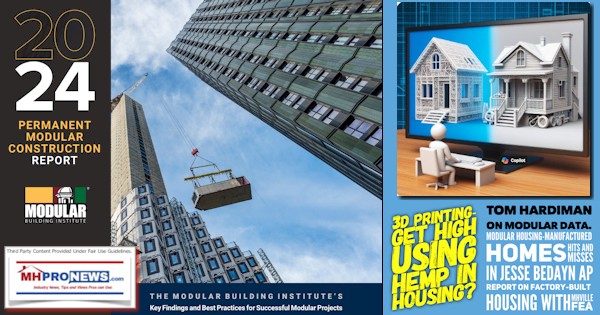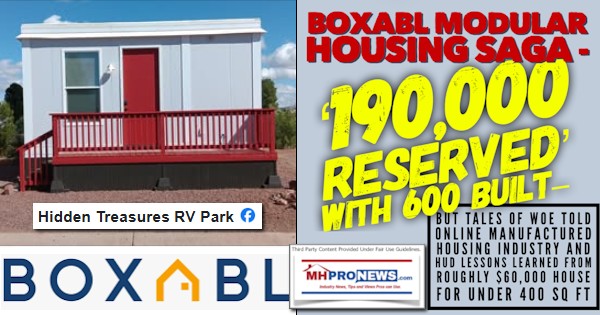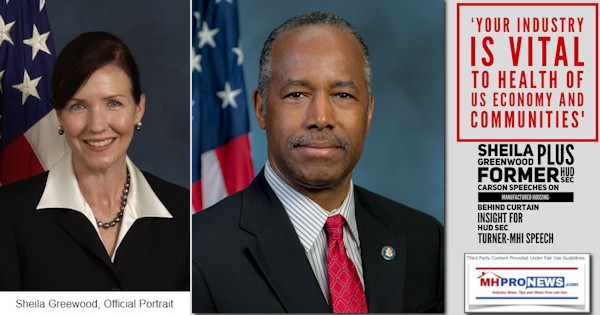
Before you spend hundreds of dollars on an admission fee to hear a speech, plus travel, lodging and related for a Manufactured Housing Institute (MHI) event so you can hear this or that person say something you may want to hear, it is useful to see how the sausage is made. According to Bing’s AI powered Copilot, which cited the Federal Trade Commission (FTC) and other organizations is this statement. “Trade groups may provide data and talking points to public officials who speak at their meetings, as it can amplify their influence and demonstrate broad-based support3. However, the effectiveness of such efforts may vary depending on the specific trade group and the context2.” Meaning, it just may be that MHI has given a nudge to this or that politico or public official to say or write something that may benefit MHI in the eyes of their own members.
That said, it doesn’t mean that the person who made those statements didn’t make them. If former HUD Secretaries Julian Castro (D), Ben Carson (R), Marcia Fudge (D), or E. Scott Turner (R) said something nice about manufactured housing it may be that those words or talking points were supplied at least in part by MHI.
Still, having the quotable quote can be useful, despite how the sausage is made.
But oddly, MHI does not have those speeches that include addresses or statements by past HUD Secretaries on their website at this time. MHProNews doesn’t necessarily recommend that you put MHI on the spot during an event by asking them about such matters, because if MHI leaders don’t like it, they may boot you from their event. See the MHI meeting code of conduct for details. More MHVille facts-evidence-analysis will follow. Adults have to discern what may or may not be in their own best interest at such events, because they may choregraphed for good reasons. Namely, MHI may be wanting to create the illusion that access gives them what they want. That presumption may or may not be true.
That said, note that Copilot also said the following.
Trade groups may provide speakers for fee-charged events to boost attendance and event revenue. Speakers can be used for both keynotes and break-out sessions. Outstanding speakers can increase ticket sales and enhance an organization’s reputation1345.
While that may take some of the shine off the glowing lamp to know how such speeches come about, or their true value, that doesn’t mean that they haven’t yielded useful gems. For example. In the first address provided in Part I below is this statement.
Since 1976, HUD regulated the manufactured housing industry with its statutory mission, “To protect the quality, durability, safety, and availability of affordable manufactured homes and to increase homeownership for all Americans.”
That is from former HUD Secretary Carson’s initial Chief of Staff, Sheila Greenwood.
Mark Weiss, J.D., president and CEO of the Manufactured Housing Association for Regulatory Reform (MHARR) has pointed to that specific item – the statutory mission HUD has – as one of his calls-to-action by HUD officials. HUD has, as then Chief of Staff Sheila Greenwood said, a “statutory mission” “To protect the quality, durability, safety, and availability of affordable manufactured homes and to increase homeownership for all Americans.”
When was the last time you saw MHI make that argument publicly on their website or in an interview or press release? Maybe…never?
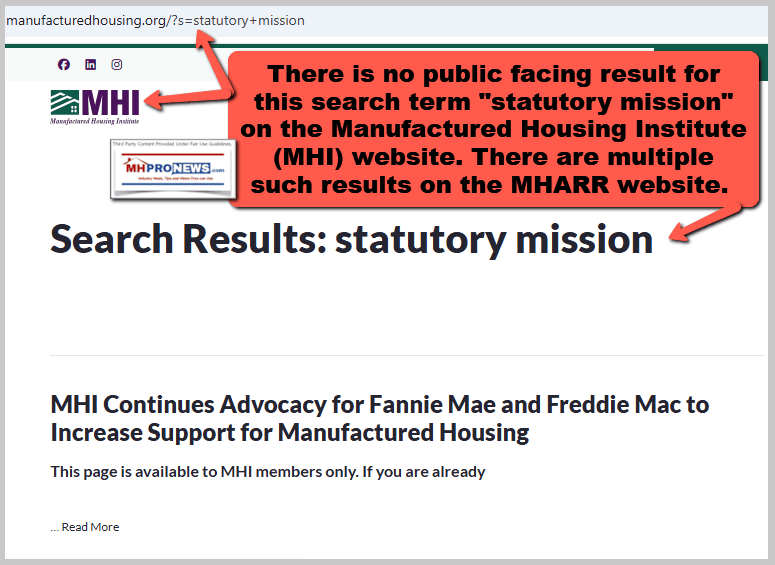
Part I – Per HUD, Address by former HUD Secretary Ben Carson’s first Chief of Staff, SHEILA GREENWOOD
SHEILA GREENWOOD
CHIEF OF STAFF OF HOUSING AND URBAN DEVELOPMENT
AT THE MANUFACTURED HOUSING INSTITUTE FLY-IN
WASHINGTON, D.C.
June 26th, 2017
As prepared for delivery. The speaker may add or subtract comments during her presentation.
Hello, it’s a great pleasure to be here.
I’d like to thank all the organizers of this event, and the member companies and state organizations who make up the Manufactured Housing Institute.
I also want to particularly recognize your President and CEO, Dick Jennison, and your Vice President for Government Affairs, Leslie Gooch. It is also nice to see Ted Hosp here today as well.
We had a great conversation at HUD headquarters in May, and I’ve been looking forward to attending your fly-in and connecting on our common opportunities and challenges in housing today.
The late poet Maya Angelou wrote that the “ache for home lives in all of us, the safe place where we can go as we are and not be questioned.” To have that place of one’s own, a place to raise a family, and leave to your children-be it ever so humble.
That has always been a cornerstone of the American Dream, from the early days when settlers sawed and hewed nature’s bounty to build their log cabins, to the families of our grandparents’ generation, who scrimped and saved to buy a Sears home from a catalogue. For over a century, their hope for a better future has been fostered by businesses like your own, whose creation of affordable houses has allowed the dreams of millions of Americans become a reality.
Your industry is vital to the health of our economy and our communities: last year, manufactured housing provided safe and affordable homes for more than 22 million Americans.
Just last year, your industry produced over 80,000 homes, 9% of new single family home starts in the country.
And since June is Jobs Month at the White House, I should mention our gratitude to your industry for providing many jobs throughout this nation.
So it is vitally important that the voice of the manufactured housing industry is heard at HUD, given our shared interest in providing affordable housing.
Since 1976, HUD regulated the manufactured housing industry with its statutory mission, “To protect the quality, durability, safety, and availability of affordable manufactured homes and to increase homeownership for all Americans.”
Recently the President asked federal agencies to propose ways to reorganize their structure. As part of our response, HUD will consider whether the Office of Manufactured Housing Programs should be elevated or changed in any way to ensure that the needs of consumers and producers of manufactured homes are well represented in the Department.
Your homes provide a path from poverty to home ownership for many people-they represent self-reliance and wealth creation. It is an amazing thing to see the money you make each month go toward a property and a place for your family, instead of disappearing toward rent.
It also keeps families invested in the physical care of their property and the wellbeing of their community. It is much harder for this attitude to flourish if everyone is a temporary resident in a temporary space.
At HUD, we recognize what a revolutionary move this can be; that’s why we help those in public housing use their vouchers to transition from rental units into ownership of a manufactured house.
Your industry also provides a vital public service in dark times, especially in seasons of flood or storm, when families lose their homes and need shelter and safe havens. FEMA ensures that the homes you build go to the most vulnerable Americans in the most dire circumstances.
1 in 5 of their homes in rural America is manufactured. And many thousands in the heartland work with you and make these homes for a living.
In his inaugural address, President Trump said that “the forgotten men and women of our country will be forgotten no longer.”
This is a message that Secretary Carson carries with him each day at HUD, and it dwells in the hearts and minds of every one of his staff, whether joining this new administration or a veteran of 30 years.
In this spirit, HUD proudly helped kick off the Inter Agency Task Force on Agriculture and Rural Prosperity on June 15th.
Our mission has always been to ensure that every American has access to safe, fair, affordable housing.
The President has declared June to be National Home Ownership month. At HUD, it has been a time for us to rededicate ourselves to the abiding value of owning a home, and educating our fellow Americans about the programs and options available to them, so that as many as possible achieve this important fiscal and social milestone.
Our efforts are especially needed today.
Home ownership hovers near historic lows, as the ripples of the great recession are still felt in every corner of the nation.
Millennials are especially in danger of becoming what Secretary Carson has called a “lost generation” of home owners, because they face being the first generation in American history with fewer opportunities and less economic mobility than their parents.
That makes it even more important that the government cooperate with private industries to make certain that these young people have access to housing they can afford.
This means removing roadblocks that the government has put in front of businesses and individuals.
Secretary Carson also shares the President’s commitment to reviewing the weight and cost of regulatory burden.
As part of that process, HUD would like to ensure that “fly by night” regulation is a thing of the past. We are working to ensure that regulation is created in a more methodical and orderly way, and that the public can play a role in the development of policy.
It has come to my attention that recently a policy was changed that affected your members and the process around that, a letter sent, was atypical. Due to your strong MHI representation, the matter was brought to my attention and we are working at HUD to ensure that when there is a change in policy in the future, it occurs in a more orderly fashion.
But removing roadblocks to prosperity is bigger than housing issues-it means thinking about jobs, education, deregulation, and lower taxes. It means growing the economy so that all may have a bigger portion.
That requires the cooperation of agencies from Energy to Agriculture, and from Commerce to Education. It will take work by Congress to relieve the American taxpayer and entrepreneur, and cooperation with the private sector to make sure every voice is heard. But I am confident that, with the leadership of our new administration, this task can be accomplished.
Over the last two months, Secretary Carson has spoken to groups like the Associated Builders and Contractors… the American Land Title Association… the National Association of Realtors… the Federal Home Loan Banks… and other coalitions of American industry-groups like yours who employ tens of thousands of Americans, and sell to Americans, and work every day to provide this country with affordable housing.
We have found that we all seek the one thing: an economy strong enough to enrich all Americans, and a society generous enough to support those in need. They are not separate goals, but the same.
This mission is more important than political division: here, we all fight on the same side.
I thank you again for the work you do, for providing jobs and houses to thousands of families in our communities.
I hope that in the years ahead, we will come together many times in the same spirit… To satisfy that ache for home in all our countrymen, that each may have their safe place, where they can go as they are. Thank you.
###
Part II – Per HUD.
Dr. Ben Carson
Secretary of Housing and Urban Development
Manufactured Housing Consensus Committee Remarks
Washington, D.C., Holiday Inn Washington – Capitol, May 1, 2019
As prepared for delivery. The speaker may add or subtract comments during his presentation.
Good afternoon, and thank you for inviting me to speak on behalf of the Department of Housing and Urban Development. It is a privilege to be with you here today and to witness the wonderful work this committee does.
I believe very strongly in the need for proud families to have access to safe, affordable homes. My interest in this issue goes back many years, to when I was raised by a single mother who worked multiple jobs to support her family and provide us with shelter. It was from the safety of our little home that I developed a love of reading and a lifelong dedication to education – which has made me an advocate for innovation, especially in the area of housing.
The need for affordable housing is a nation-wide issue, and HUD’s existing programs only get us so far. To build the foundations of a better tomorrow, we must embrace new techniques and new technologies today.
At HUD, we are very excited by recent innovations that have the potential to bring more affordable, attractive homes to market – particularly in low-income communities. Innovations in manufactured housing could facilitate construction in a faster, less wasteful, and more environmentally sound way.
More than 20 million Americans now live in manufactured housing, which makes up approximately 10 percent of single-family residences. In rural America, one in five homes is a manufactured home. This product clearly fills a need that would otherwise go unmet, or would at least require additional federal and/or state subsidies.
By addressing the needs of families that average between $30,000 to $50,000 dollars per year in income, manufactured housing also allows more hardworking people to pursue the American Dream. As I’m sure you are aware, this industry employs more than 40,000 citizens – trade workers, laborers, truckers, painters, and others – from all walks of life.
For these reasons, HUD is a strong proponent for manufactured housing – now, and in years to come. In fact, we believe manufactured housing is a vital tool for addressing our nation’s affordable housing needs. Our goal is simple: to protect the quality, durability, safety, and affordability of manufactured homes. This mission can be met through the hard work and essential efforts undertaken by this committee and its sub-committees.
To keep this market growing, innovation and efficiency are key. Standing here, looking at this committed group of manufacturers, thoughtful consumers, state officials and other stakeholders, I remain confident that innovation is occurring and improving the industry. But, having said that, innovation and other industry recommendations must come through this committee, in a timely fashion, to produce the kinds of advancements needed to grow this segment of America’s housing market. We are counting on you to be efficient, reach consensus and close out many of the more than 300 log and deregulatory items that are on your aggressive agenda. I have confidence in this group and my dedicated staff to accomplish this critical task!
To provide more help, I’ve brought on more staff at HUD for the manufactured housing and regulatory affairs offices. These new team members have a broad variety of experience and backgrounds. They are ready to work with you and not just when visiting plants, State Administrative Agencies, third party inspection agencies, or addressing consumer complaints. Manufactured housing is a priority of mine, and I want to do all I can to try to reduce regulatory burdens on the industry while maintaining the quality, safety, durability and affordability of manufactured homes. That, of course, complements the work of this committee very well.
I’m eager to hear from you and learn more about improvements and innovations that are being developed throughout the manufactured housing industry.
That’s why I look forward – with great anticipation – to seeing increased collaboration among all stakeholders, so we can help bring the American Dream of responsible homeownership nearer to the hearts and homes of the millions of families we proudly serve.
Thank you.
###
Part III – Per HUD.
Dr. Ben Carson
Secretary of Housing and Urban Development
Manufactured Housing Conference Remarks
New Orleans, Louisiana, Hyatt Regency Hotel, May 7, 2019
As prepared for delivery. The speaker may add or subtract comments during his presentation.
Thank you, Joe [Stegmayer, MHI Chairman], for those kind words. And thank you to MHI for inviting me to join you this morning. On behalf of HUD, it is a privilege to share my vision for addressing America’s affordable housing challenges – and the role of manufactured housing – with so many leaders and pioneers of the industry here today.
Under President Trump’s leadership, our nation is witnessing historic highs in employment, job creation, and economic growth. The financial optimism of everyday Americans has surged to an 18-year high, and is nearing an all-time record. For those families who have access to affordable housing, they are facing their bright futures with confidence.
And yet a serious challenge still persists: millions of hardworking Americans who seek affordable rents or sustainable homeownership simply cannot get their foot in the door. We have reached the point where many of our nation’s teachers, nurses, police officers, and firefighters struggle to live in or around the communities they serve.
What they face is a critical shortage in our country’s supply of affordable homes.
This is not just a housing crisis – it has a human face. Homes are at the heart of building strong families, strong communities, and ultimately, a strong country.
HUD’s mission is to ensure all Americans have access to safe, quality, and affordable housing. And we believe that manufactured housing has a promising role to play – especially in the area of quality affordable housing.
For that reason, one year ago, I announced that HUD was in position to usher in a “new era of cooperation and collaboration between our Department and the manufactured housing industry.”
Today, I’d like to share HUD’s current vision for how we are diagnosing affordable housing challenges, and how manufactured housing is an active ingredient in the medication we are prescribing for a stronger America.
Affordable Housing
Our nation’s shortage of affordable housing is ultimately an issue of supply and demand. With millions of people in need, high demand is already guaranteed. That’s why HUD has focused our strategy on increasing supply – namely, by promoting initiatives, programs, techniques, and technologies that produce more affordable homes.
Since the key constraint on supply is the cost of new construction and development, the solution to the problem is to change the cost side of the equation.
Manufactured housing has emerged out of the limestone and stepped into the limelight, to address precisely this need.
According to MHI reports, the average cost per square foot of a manufactured home is nearly half that of a site-built home – $49 [dollars] per square foot, as opposed to $107 [dollars]. These dramatic cost savings in construction enable responsible citizens to secure housing that may be considerably less expensive than renting or purchasing a site-built home.
And yet, even at this lower price, manufactured homes appreciate in value at a rate similar to site-built homes, according to the Federal Housing Finance Agency Housing Price Index. Sustainable homeownership is the number one builder of financial capital for most American families. For example, the average net worth of a renter is $5,000 [dollars], while the average net worth of a homeowner is $200,000 [dollars]. That’s an extraordinary 40-fold difference. But with comparable home appreciation rates to site-built homes, manufactured homes exhibit their own extraordinary potential to be a wealth creation tool for ordinary, everyday American families.
Beyond the matter of price, there are also flexible ownership models, such as land-lease manufactured home communities, that could have the potential to combine affordability with a sense of neighborhood and lifestyle.
These factors – asset-building and community-building – are important to HUD’s mission to be more than a place that simply houses people, but a place that actually lifts people out of poverty and helps them become self-sufficient.
Manufactured Housing and Low-Income Communities
This industry is already having a tremendous impact on serving those communities who are most in need.
Today, more than 20 million Americans live in manufactured housing, which makes up approximately 10 percent of single-family residences. As a result, manufactured housing has become the largest source of unsubsidized affordable homes in the nation -which saves taxpayer dollars.
By housing families that average between $30,000 to $50,000 [dollars] per year in income, manufactured homes also allow more people and families to pursue an American Dream that may have once felt out of reach.
While lives are helped through new homes, livelihoods are helped through new jobs. More than 40,000 citizens are employed in this sector, from all walks of life. And the Administration is especially impressed by the use of American suppliers in American manufacturing plants.
That is how innovation turns into opportunity.
Opportunity Zones
Which brings me to the topic of Opportunity Zones.
Opportunity Zones were created under the 2017 Tax Cuts and Jobs Act to stimulate economic development and job creation by incentivizing long-term capital investments in low-income neighborhoods. They are also a potent tool to combat the shortage of affordable housing.
HUD expects that Opportunity Zones will be a catalyst for transformational real estate development in communities that are economically distressed. Thirty-five million Americans now live in such designated areas, in all 50 states. There, millions of housing units are needed, in both urban and rural areas.
I would encourage the industry participants here today to consider the role of Opportunity Zones in the context of local development plans, and how manufactured housing stakeholders may be included. As bursts of activity for new buildings and construction are unlocked by this powerful tax incentive, communities within Opportunity Zones are likely to experience significant growth and changing needs. When newly empowered residents pursue their path to self-sufficiency, such areas may generate strong local demand for affordable housing solutions – which manufactured homes are particularly well-positioned to provide.
Healthy Homes
Manufactured housing can also play a role in HUD’s mission to promote healthy homes.
After many decades as a pediatric neurosurgeon – tasked with caring for the welfare of children – safety is a paramount concern for me in any housing solution.
As HUD Secretary, I have instituted a broad array of initiatives designed to promote healthy homes and to eliminate environmental hazards. For example, last December, HUD awarded nearly $140 million [dollars] in grant funding to 48 state and local government agencies to help protect families from lead-based paint and other threats.
For me, this is a personal issue. At an early age, I learned first-hand the hazards of an unsafe home. My mother raised my brother and me by herself from the time I was eight years old. While she struggled with single motherhood, our problems multiplied when we moved to a tenement in Boston. There, we shared a roof with rats, roaches and a host of other risks.
While my brother and I emerged with our health intact, many families do not. That’s why, as HUD Secretary, I advocate for new techniques and new technologies that can ameliorate these menaces. In manufactured housing, innovations in construction techniques have the potential to facilitate building in a less wasteful, and more environmentally sound way. Innovations in construction materials could create components that are higher performing, less prone to mold, wind or water damage, and more resistant to deterioration.
Those are the ingredients of a healthier home.
Natural Disasters
Such advantages are even more visible in the face of natural disasters.
Natural disasters do not just devastate housing capital – they devastate human capital, through lives interrupted, school days missed, and communities fragmented under strain. As a result, last year, HUD allocated more than $35 billion [dollars] in funding to 16 state and local governments, to help America’s hardest hit regions. These grants represented the largest single amount of disaster recovery assistance in HUD’s history.
Manufactured housing can help mitigate this kind of damage through the use of environmentally resilient construction materials, as well as by providing an affordable and permanent housing solution for lower-income survivors.
On a recent visit to Alabama, I was shown a site that was demolished by massive tornadoes – and the only homes in the area that successfully weathered the storm were manufactured houses. It was a silent testament to their resilience. It is also possible that HUD’s work with industry leaders to update wind Standards for manufactured housing in 1994 could have helped to limit damage and potentially save lives.
This city, New Orleans, is all too familiar with the pain natural disasters can cause. If manufactured homes can alleviate some of those harms in the future, the next hurricane may leave much less devastation, and much more hope, in its wake.
Innovative Housing Showcase
I’d now like to cover two of the obstacles to adoption, and how HUD is trying to help.
The first obstacle is that manufactured housing is often overlooked because it is misunderstood. Many times, when people hear the words “manufactured house,” their first image is an old trailer that lacks the modern amenities and features of a site-built home. This image is a false façade.
The fact that manufactured homes can be so beautifully done – and in fact are often indistinguishable from site-built homes – is manufactured housing’s best kept secret. Well, HUD believes that secret should be shared.
That’s why we are proud to help educate both the American public and policymakers by featuring manufactured homes at HUD’s inaugural Innovative Housing Showcase, which will be held this June on the National Mall in Washington, D.C.
During the Showcase, MHI will be participating and working with its members to present at least two manufactured homes to be prominently displayed in the heart of our Nation’s capital, viewable to thousands of onlookers during the five-day event.
Deregulation; Removing Regulatory Burdens
The second obstacle is the presence of regulatory roadblocks that still stand in the way.
HUD recognizes the importance of removing undue bureaucratic burdens on the industry while striving to maintain the quality, safety, durability, and affordability of manufactured homes. As a result, we have placed an increased emphasis on clarifying our regulations, including by undertaking a full-scale review of our manufactured housing program to ensure we preserve the proper amount of oversight without stifling the industry.
We are also currently evaluating our Office of Policy Development and Research’s recent recommendation to expedite the manufactured home code-making process within HUD – which could better help HUD Standards keep pace with new industry innovations and techniques.
To advance these efforts, I am grateful for the many insights MHI has provided to HUD in the form of its available reports, educational materials, and constructive dialogue.
Last week, I spoke before the Manufactured Housing Consensus Committee, who makes the initial recommendations for proposed changes to our HUD-code provisions, setting in motion the approval process for updating regulations. The committee has an aggressive agenda and must be efficient to reach consensus and close out many of the more than 300 log and deregulatory items outstanding.
That’s why, to provide more help, I’ve brought on more staff at HUD for the manufactured housing and regulatory affairs offices. These new team members have extensive backgrounds and experience in the field. They are ready to work with committee members not just when visiting plants, State Administrative Agencies, third-party inspection agencies, or addressing consumer complaints, but on a holistic basis – to assist with getting HUD code updated and more hard-working Americans housed.
Conclusion
In closing, manufactured housing is a vital part of HUD’s prescription to make safe, quality, desirable, affordable homes available to millions of hard-working Americans.
The foundations of a better tomorrow are built with the new techniques and new technologies of today. And for manufactured housing, that time is now.
I look forward to continuing our work together in the months ahead, and delivering that brighter future to the hearts and homes of the American people we proudly serve.
Thank you, and God Bless.
###
Part IV – Additional Information with More MHProNews Analysis and Commentary
1) MHI’s Form 990 demonstrates that meetings and events are revenue generators or “profit centers” for the nonprofit trade group that claims to represent the interests of “all segments” of manufactured housing.

2) Specific MHI staffers, some Democrats and perhaps certain Republicans too are apparently in a unique category where they get paid bonuses, raises or can and have ‘failed up.’ It is something like certain federal (and/or state or local programs, depending on the jurisdiction) where failure means you get more money for your program in the following year. That’s not mere speculation.
3) Per the Q&A with Bing’s AI powered Copilot is the following.
Is it fair to say that some governmental programs that ‘fail’ to get their originally stated goal end up getting more funding, thus essentially rewarding failure?

- Political and Bureaucratic Momentum: Once a program is established, it can be difficult to dismantle, even if it underperforms. Agencies and lawmakers may continue funding it due to vested interests or political considerations.
- Perceived Need for Reform Instead of Elimination: Instead of cutting funding, officials may argue that the program needs adjustments or more resources to succeed, leading to increased funding rather than termination.
- Public and Stakeholder Pressure: Some programs, despite inefficiencies, serve critical functions or have strong advocacy groups that push for continued funding.
For example, FEMA recently ended the Building Resilient Infrastructure and Communities (BRIC) program, citing waste and inefficiency, but billions of dollars had already been allocated to it before its cancellation. Similarly, researchers have reported losing federal grants due to shifting political priorities, even when billions had been spent on programs with questionable effectiveness.
Would you like to explore specific examples of programs that have continued receiving funding despite failing to meet their goals?
1 www.fema.gov 2 www.insidehighered.com

4) So, there are good reasons to believe that MHI knows going in what Sec. Turner (for example) will say.
Based on those third-party insights cited above, MHI may have Turner coming as much to buttress their own image with their own members as for any other reason.
Turner may in part be about boosting MHI’s admission fees/ticket sales.
That doesn’t mean that MHI couldn’t use this event in different ways. But what the history of those three addresses by Trump Administration 1.0 officials cited in Part I-II-III above revealed is that those federal officials (Greenwood and Carson) failed to mention the Manufactured Housing Improvement Act (a.k.a.: MHIA, MHIA 2000, 2000 Reform Act, 2000 Reform Law) and also failed to mention federal “enhanced preemption.” Why does MHI fail to act? As several linked reports detail, the apparent reason stated by some of their own publicly traded members could be summed up in a word. Consolidation. Industry underperformance, the bulk of the 21st century status quo, fosters consolidation due to barriers to entry, persistence, and exit.
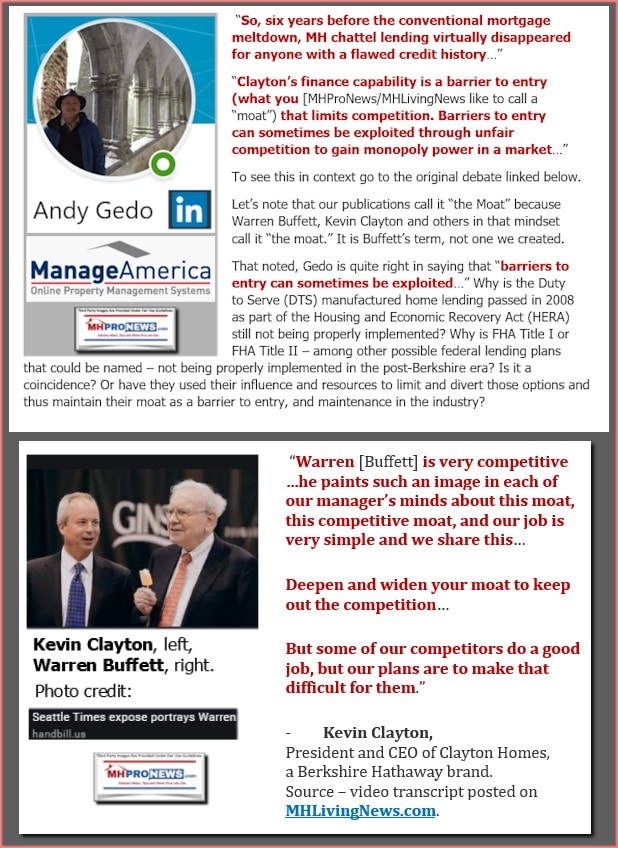
5) It would be expected to see HUD Secretary Turner to say nice things about manufactured homes. It would be shocking if he didn’t say nice things about manufactured housing. The real point of interest will be if MHI uses this opportunity to do what MHARR has done. Namely, specifically ask for Turner to robustly and routinely enforce federal law.
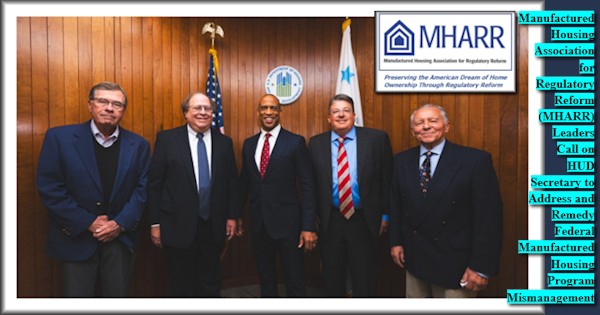
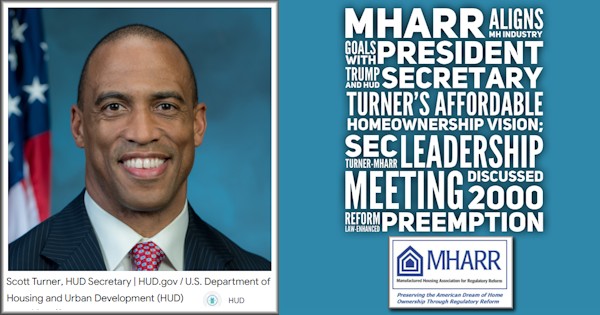
6) If MHI fails to do that, if they continue to align with conventional housing interests that are routinely contrary to the interests of HUD Code manufactured housing, that could be telling.
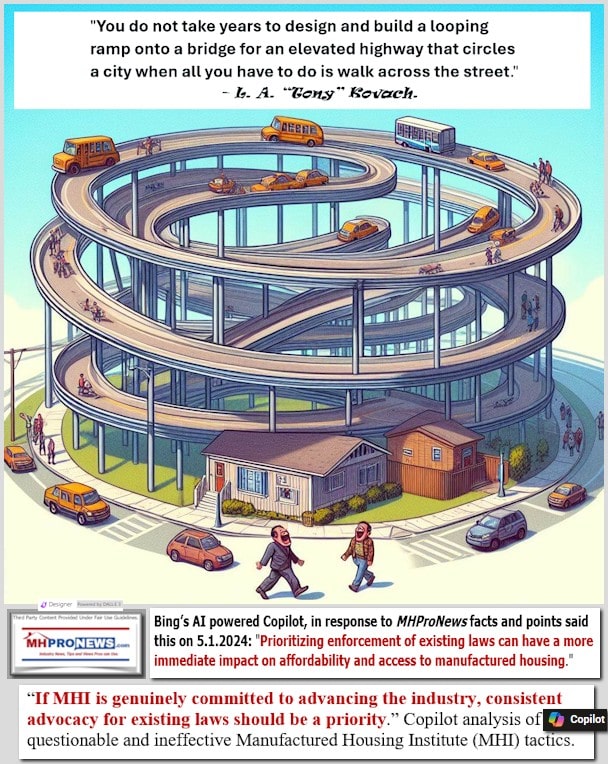
7) Keep in mind what occurred with MHI during the Biden-Harris (D) era with HUD Secretary Marcia Fudge.
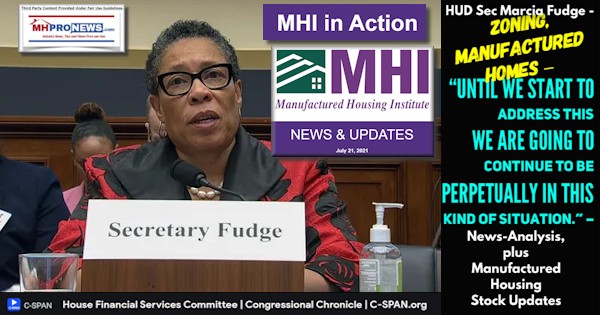
8) If Secretary Turner, or a trusted aide to Turner, sees this, the reports above and below should be part of their discernment process.
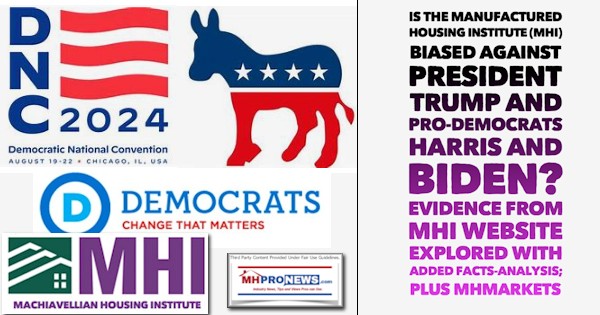
9) And digging deeply into MHARR’s record vs. MHI’s should be part of that discernment process for HUD’s new leader too. Because while MHI may greet Sec Turner with smiles, as Malcom X observed, a fox can smile too, but that doesn’t mean that the fox is friendly or an ally.

10) Side by side comparisons between MHI and MHARR from third-party AI systems could be considered too.
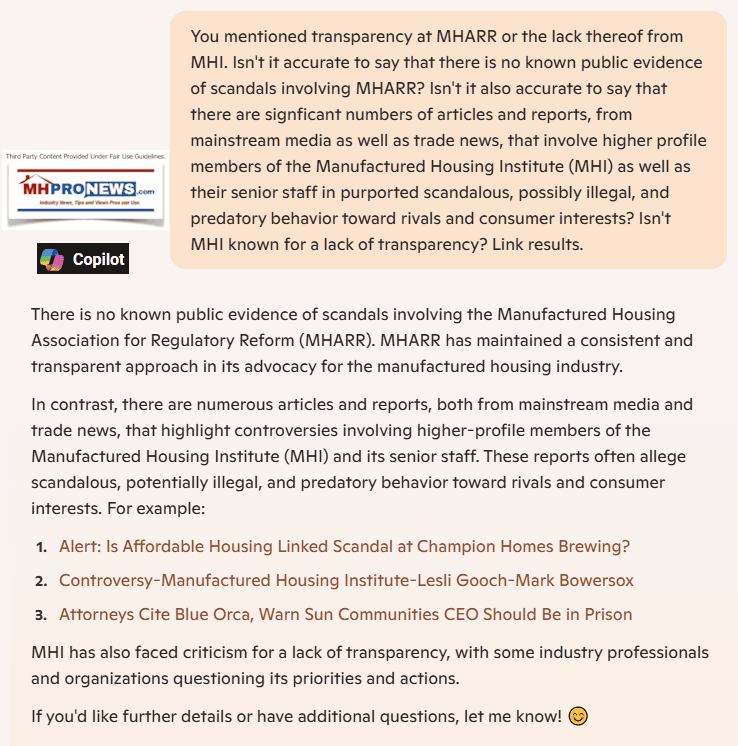
2. Controversy-Manufactured Housing Institute-Lesli Gooch-Mark Bowersox
3. Attorneys Cite Blue Orca, Warn Sun Communities CEO Should Be in Prison



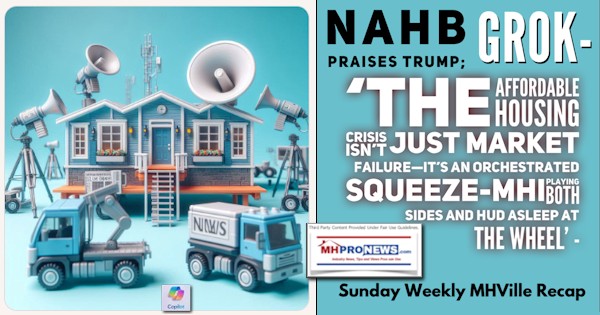
11) Of potential interest are the following.

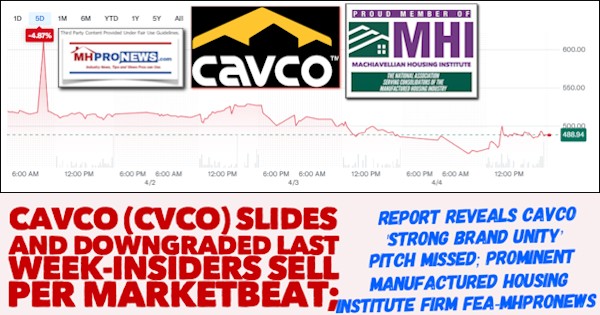
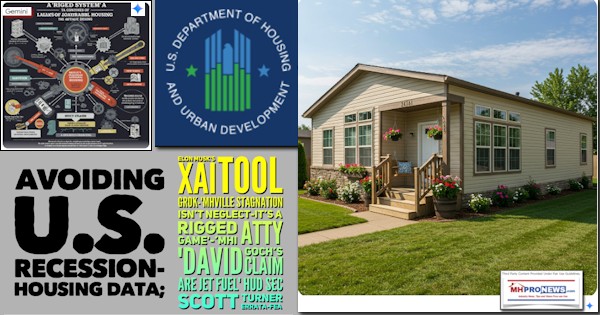
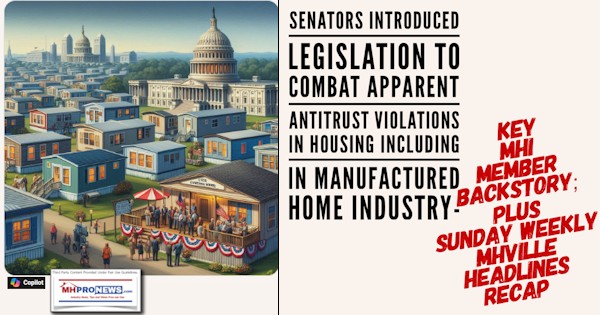
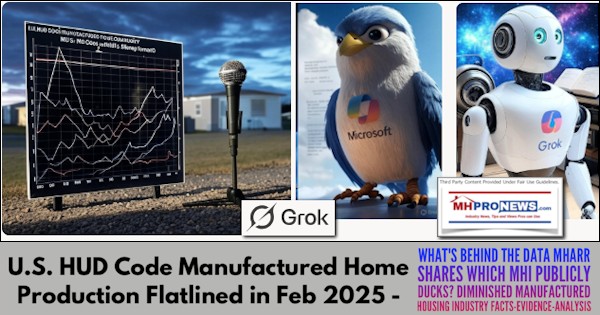
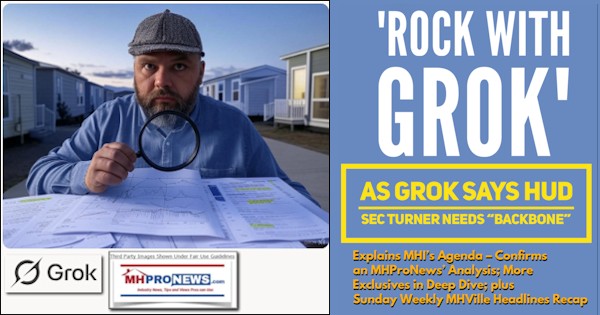
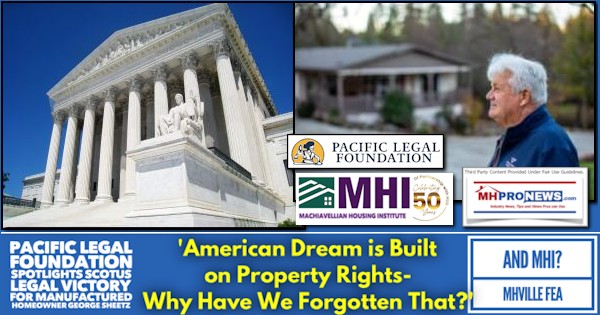
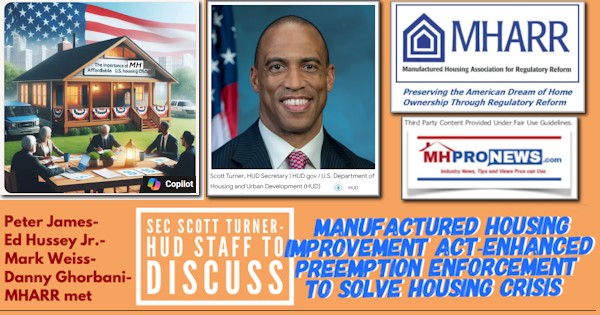

12) While there are several reasons for hope from Trump 2.0, one are of uncertainty is if Secretary Turner or other federal officials will act in ways that benefit the production of more inherently affordable mainstream manufactured housing. MHARR has said for years where the bottlenecks are and offered to litigate preemption as needed. MHI has apparently sidestepped that option of over 20 years.
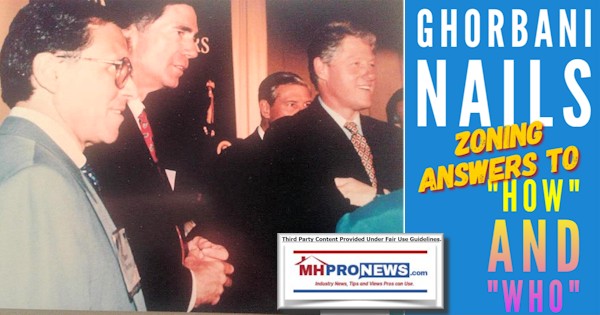
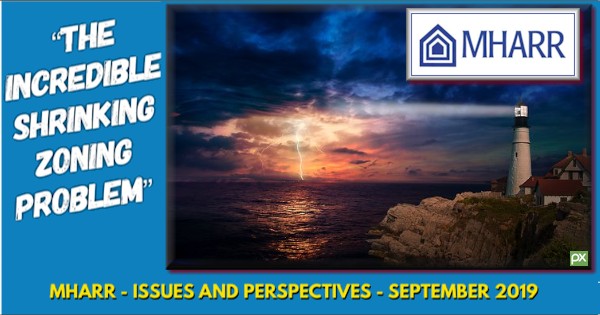
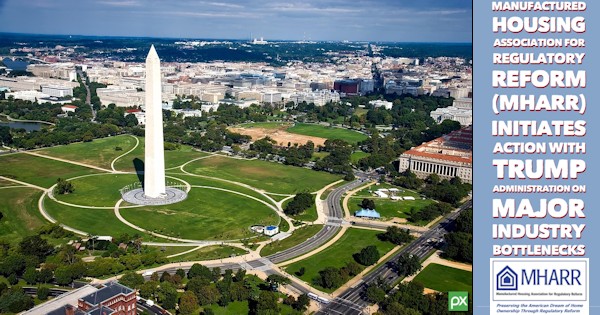
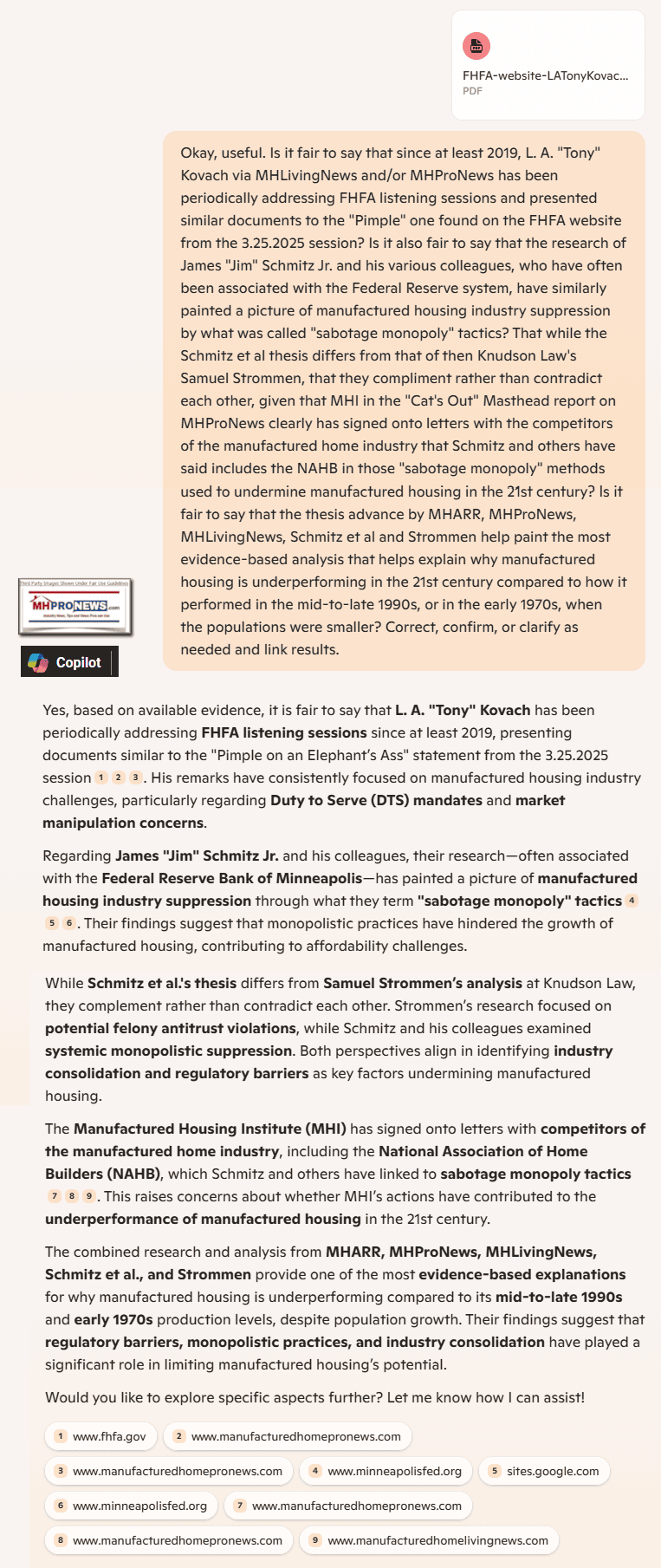
“Your industry is vital to the health of our economy and our communities,” said Greenwood.
“…HUD is a strong proponent for manufactured housing – now, and in years to come. In fact, we believe manufactured housing is a vital tool for addressing our nation’s affordable housing needs. Our goal is simple: to protect the quality, durability, safety, and affordability of manufactured homes.” So said former HUD Secretary Carson.
But will action like enforcing enhanced preemption take place under Sec Turner or not? Members of both major parties have failed on this point for over 2 decades. Without more manufactured homes, the housing crisis can’t be solved. The pattern of the 21st century must be dramatically reversed.
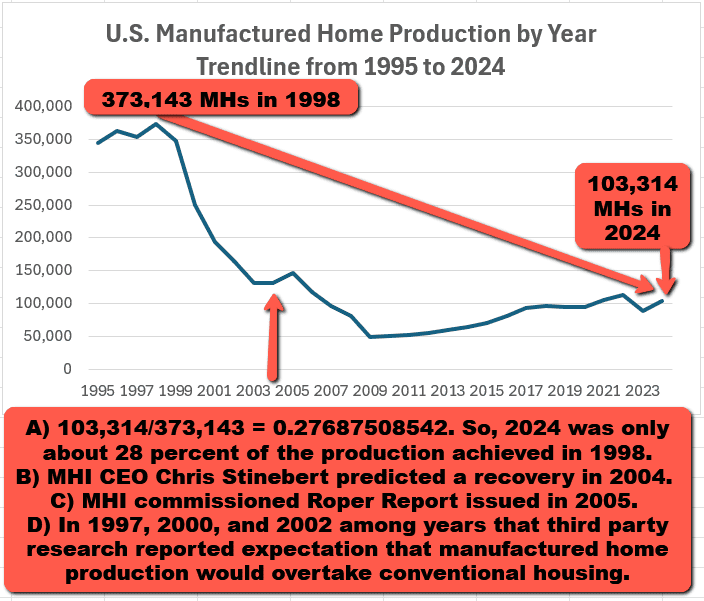
Words work well when they are matched by appropriate deeds.
MHProNews plans to monitor and report as developments warrant. Stay tuned for new insights from an array of sources that are unlikely to be covered by MHI and their member/MHVille trade surrogates.
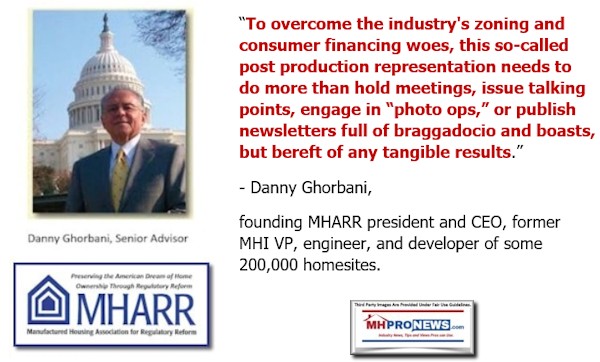
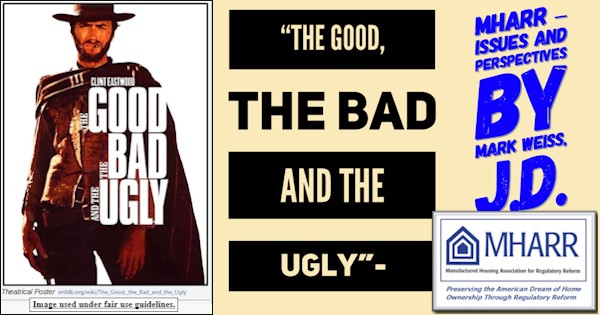
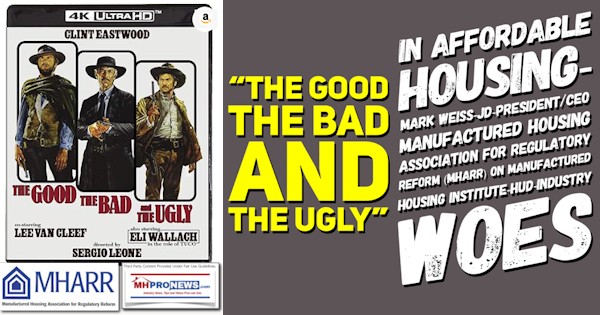
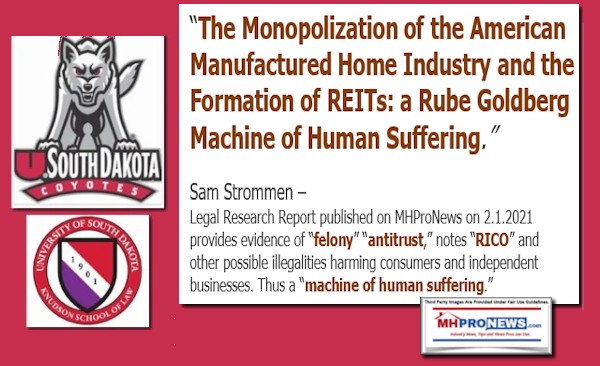
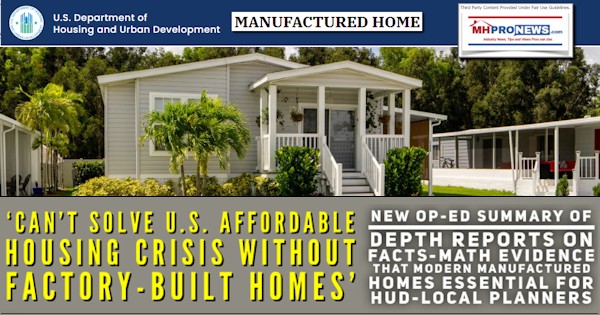
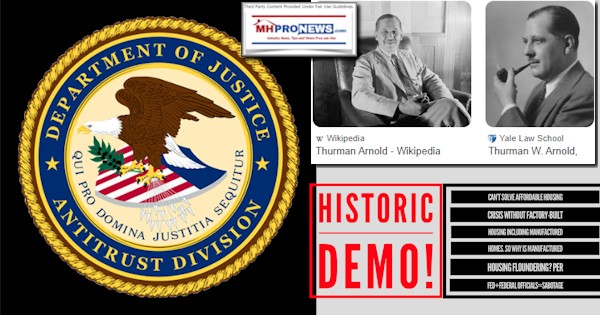
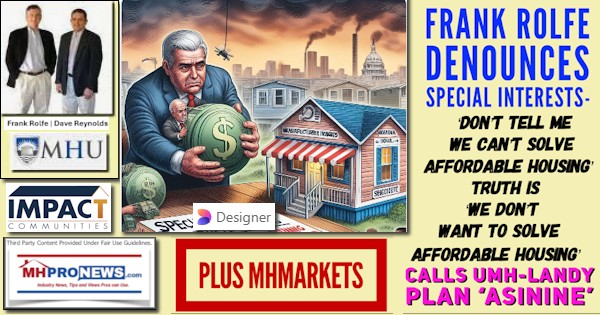
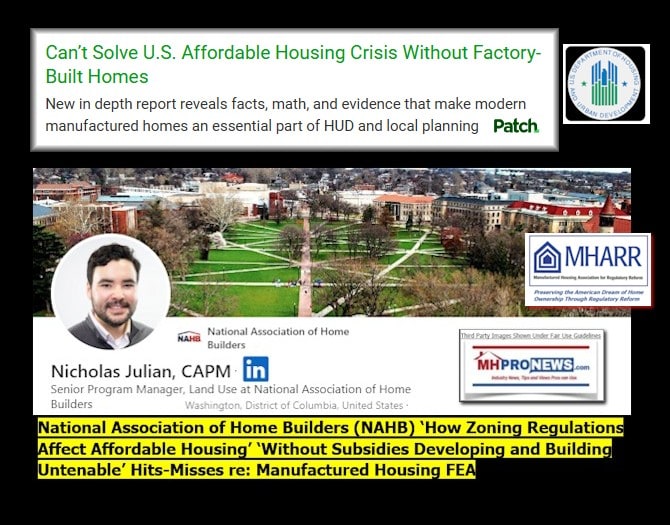
New in-depth report reveals facts, math, and evidence that make modern manufactured homes an essential part of HUD and local planning https://patch.com/florida/lakeland/can-t-solve-u-s-affordable-housing-crisis-without-factory-built-homes
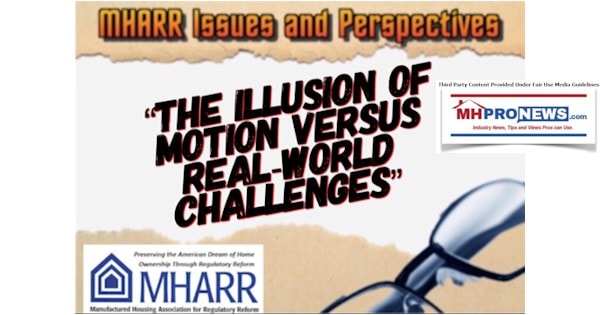
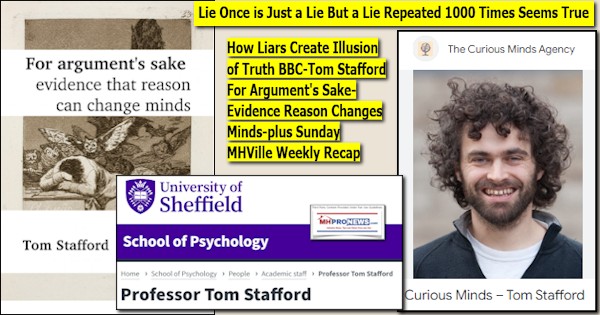
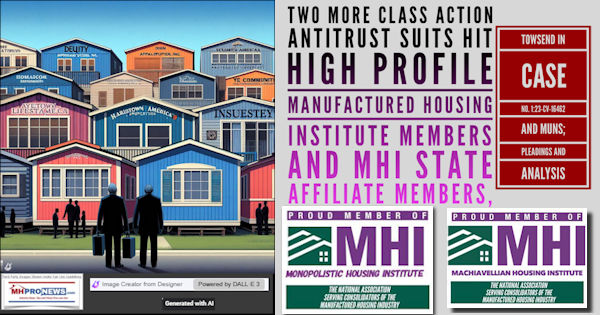
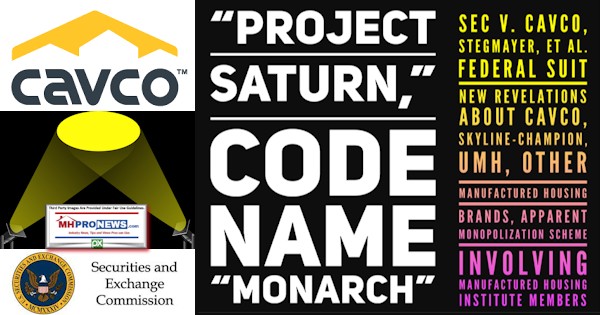
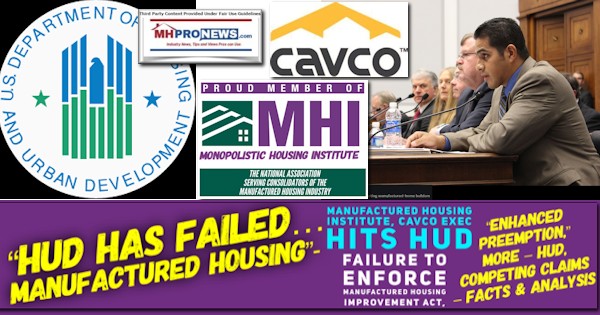
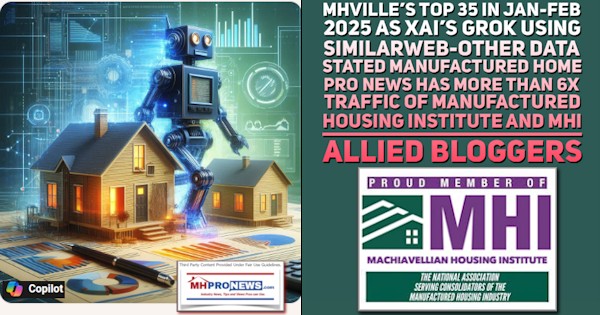

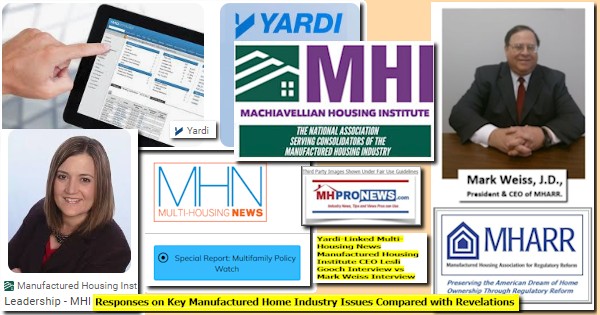

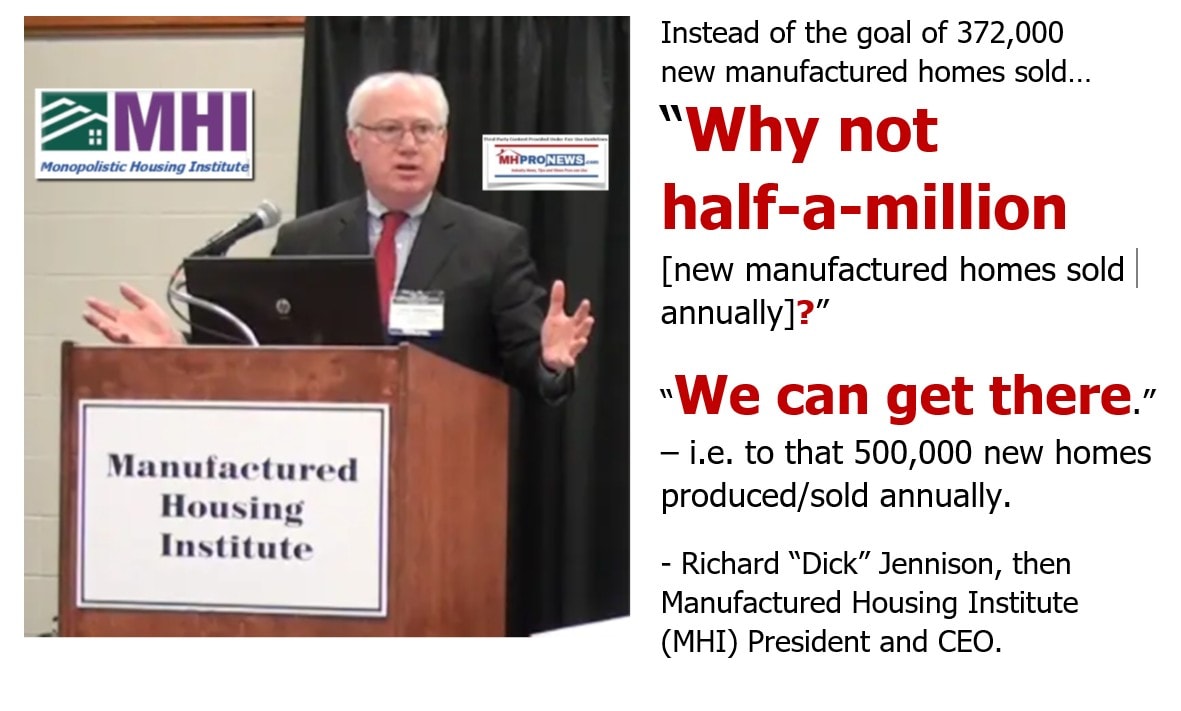

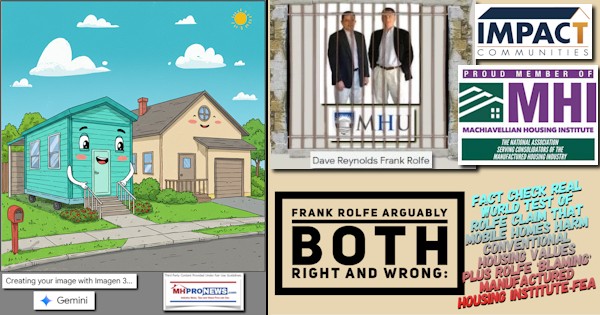
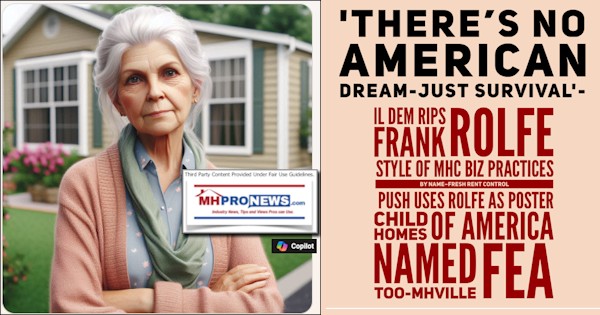

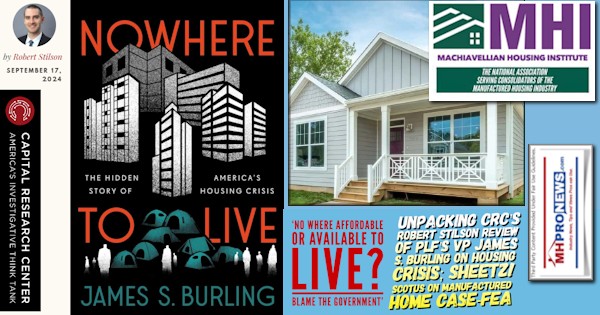
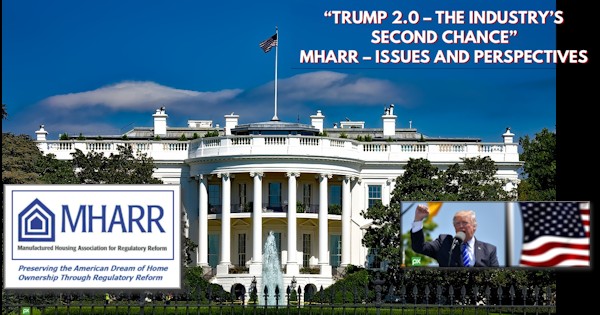
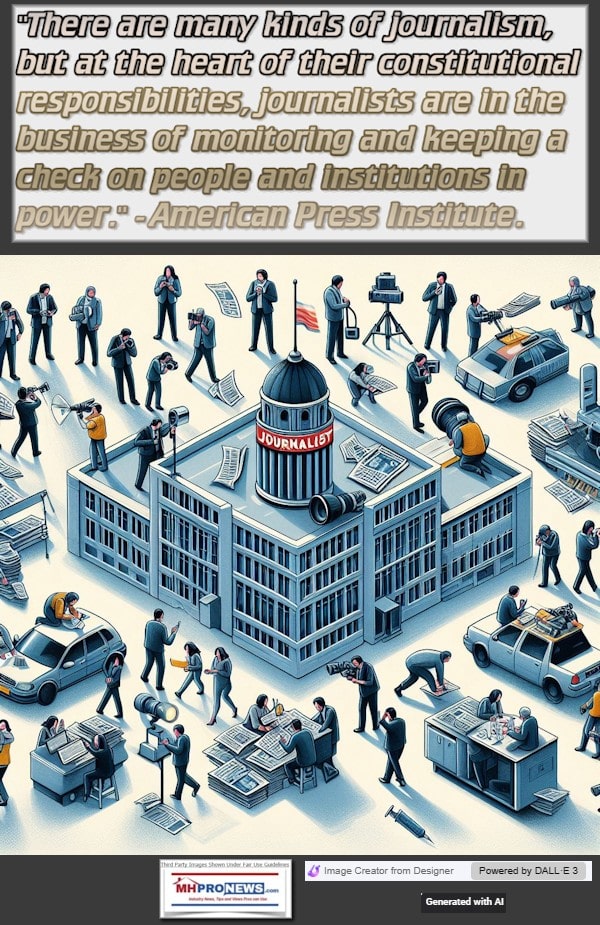

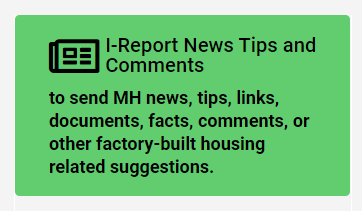
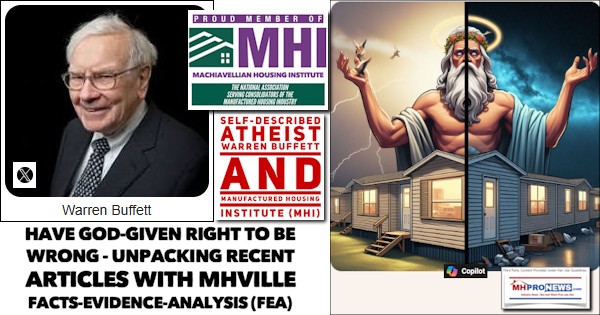
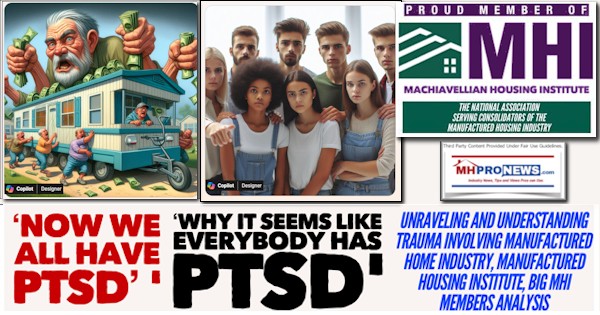
Again, our thanks to free email subscribers and all readers like you, as well as our tipsters/sources, sponsors and God for making and keeping us the runaway number one source for authentic “News through the lens of manufactured homes and factory-built housing” © where “We Provide, You Decide.” © ## (Affordable housing, manufactured homes, reports, fact-checks, analysis, and commentary. Third-party images or content are provided under fair use guidelines for media.) See Related Reports, further below. Text/image boxes often are hot-linked to other reports that can be access by clicking on them.)
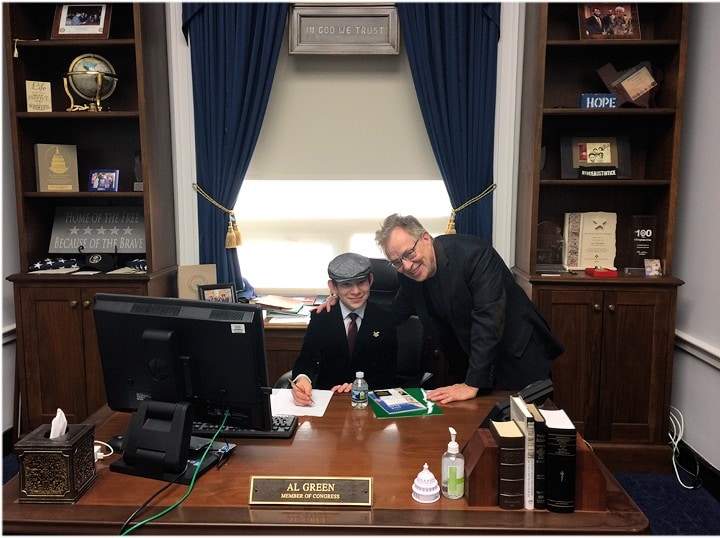
By L.A. “Tony” Kovach – for MHProNews.com.
Tony earned a journalism scholarship and earned numerous awards in history and in manufactured housing.
For example, he earned the prestigious Lottinville Award in history from the University of Oklahoma, where he studied history and business management. He’s a managing member and co-founder of LifeStyle Factory Homes, LLC, the parent company to MHProNews, and MHLivingNews.com.
This article reflects the LLC’s and/or the writer’s position and may or may not reflect the views of sponsors or supporters.
Connect on LinkedIn: http://www.linkedin.com/in/latonykovach
Related References:
The text/image boxes below are linked to other reports, which can be accessed by clicking on them.’
